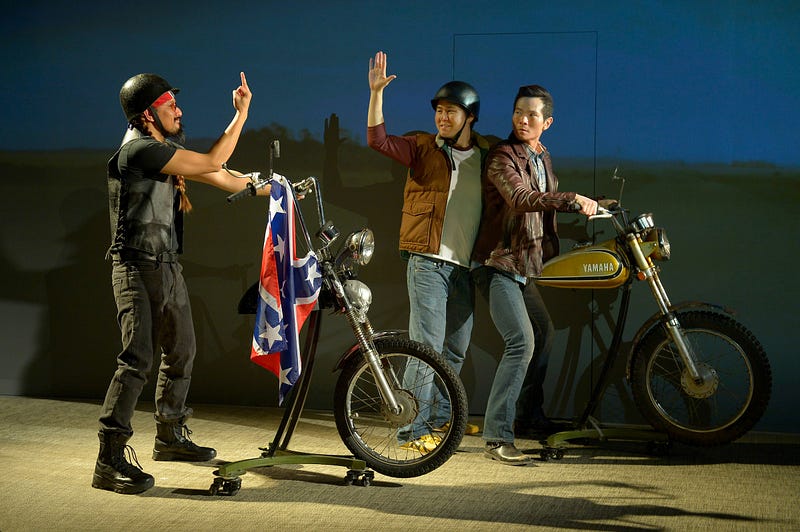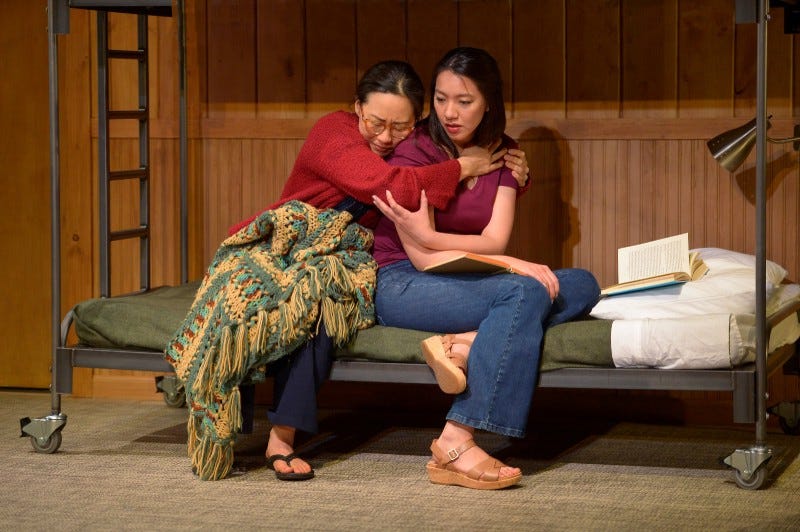
The last twenty minutes of Qui Nguyen’s Vietgone, in a new production by San Francisco’s American Conservatory Theater, feature an incredibly touching coming-to-terms between Quang (James Seol), who immigrated to the U.S. from Vietnam in the early 1970s, and his grown son, a playwright (Jomar Tagatac, who plays multiple roles).
In searching for a sense of personal identity, the younger man is more focused on the troubles of his father’s distant past than the relatively fortunate upbringing that’s been provided for him; as a result the older man feels his efforts are underappreciated.
That tonally perfect, beautifully written scene — which could almost stand on its own as a short one-act — made me see the nearly two hours that preceded very differently. Unfortunately, it made me see them for the worse. In the light of the closing passage’s naturalistic dialogue, delicately plumbed emotions and unforced humor, the techniques displayed in the bulk of Vietgone feel unpolished and too clever for their own good.
This is not to say that Vietgone is unworthy of your attention. The story it tells is an important, under-recognized one. And the ambition and bravado of its writing and direction are impressive, offering a wealth of provocative and disarming narrative techniques. Many of the production’s elements are inspired, just not refined.
Nguyen and director Jaime Castaneda — longtime collaborators — have crafted a collection of short scenes that draw on sketch comedy, action movies, hip-hop, metafiction and more to tell the story of Quang and Tong (Jenelle Chu), Vietnamese refugees who meet at a resettlement camp at Fort Chaffee, Arkansas.
The couple eventually falls in love and begins to build a new American life together, but not before Quang splits for a long motorcycle trip with a buddy (Stephen Hu, multiple roles), hoping to reach a ship back to their homeland and the wife and children he was forced to leave behind. Meanwhile, Tong must slowly allow herself to experience emotions again, having locked them down to cope with war trauma. She also needs to navigate camp life with her mother (Cindy Im, multiple roles), a character inexplicably written as a sex-crazed buffoon.

The pace is fast, punctuated by slapstick jokes and the recorded beats behind characters’ frequent rapped soliloquies. Those raps are particularly disorienting. Hip-hop wasn’t yet a force in mid-70s midwestern American culture. While the playwright grew up with rap — and Hamilton may be this decade’s defining piece of theater — its hard to understand what Nguyen thinks hip-hop adds to this particular story.
On the other hand, Nguyen’s conceit of having Vietnamese characters speak English while the American characters spew an incoherent babble of pop culture references (Cheeseburger! Botox!) is ingenious. It simultaneously conveys the befuddlement of being spoken to in an unfamiliar language and satirizes the crass lingua franca of materialism.
Vignettes in the camp, on the road and in Vietnam are played on a two-tiered set by Brian Sidney Bembridge that — combined with handsome lighting and projections by Wen-Ling Lia and Chris Lundahl — allows for speedy scenic transitions across settings and time periods, with projected captions helping the audience keep track.
This frame-and-caption technique suggests what may be the show’s most influential — and problematic — pop culture borrowing: the graphic novel. In a comic book, the physicality and energy of every discreet image is under the author’s complete control. Readers can feel every moment of Zap! Pow! action and also be instantly dropped into calm and stillness. Tone can be shifted in the blink of an eye. In this production of Vietgone, we sense the actors moving between frames, effortfully changing their energy; it feels not so much stylized as awkwardly unnatural.
There’s no question that Qui Nguyen is a whipsmart, culturally attuned writer. But Vietgone suffers from his saving the best for last.
